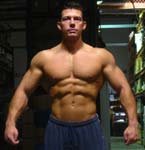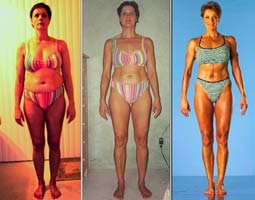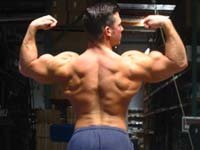Most bodybuilders strive for mass and more mass, and that can often result in body fat and more body fat. Believe it or not, a lean, ripped 200-pound bodybuilder will look much bigger than a 240-pound smooth one. It has to do with delineated muscles, etched-in granite hardness and streaking vascularity. For example, Jonathan weighed less in the second ripped photo, but it looks like he weighs at least 20 pounds more:
While most women don't want muscularity or vascularity, the same ripping diet and cutting strategies that smart bodybuilders use can get any woman leaner faster, with curves in all the right places—especially if she lifts weights to promote her metabolism and add some shapely muscle. Becky Holman's transformation photos are proof of that (more on her in the Q&A coming up).
Here are a few questions and answers from the last chapter of our best-selling e-book X-treme Lean that will put you on the road to an attention-grabbing body, whether you're a man or a woman...

[ Q ] What's the number-one thing I can do to start dropping fat immediately?
[ A ] Exercise! If you mean from a dietary standpoint, the first thing you should always do is start eating five to six protein-based meals a day. As we've said, protein has a higher energy cost than carbs, so protein-based meals will help you burn more calories and, if you keep your meals small—in the 300-calorie range—you'll limit insulin production.
That's a good thing because insulin stops fat burning and helps your body store excess calories as body fat. The only time insulin is good is immediately after a workout to help shuttle protein and carbs into your muscles. Research shows that even 100 grams of carbs (that's 400 calories) after a workout won't increase fat deposits.

[ Q ] I weigh around 215 right now. I'm pretty active, but I need a better body. If I want a fit 190-to-200-pound physique, should I drop 25 pounds to 190 and then build the muscle, or should I just drop 10 to 15 pounds and then use weight training to build muscle? I want to be a fairly ripped 190.
[ A ] First, you shouldn't be so hung up on weighing a certain amount. In fact, you probably shouldn't weigh yourself. Go by how you look (take photos, as we outline in Chapter 3). If you're losing notches on your belt, you're losing fat.
When you lose fat and gain muscle, you redistribute your weight. In other words, you'll look completely different if you lose 10 pounds of fat and add 10 pounds of muscle, but you'll weigh exactly the same. Think about that, and let it sink in.
Here are photos of Jonathan's back taken one-month apart. In the second photo he actually weighs less (to repeat: ripping up makes you look bigger and bigger as you drop ugly fat!).
So step away from the scale! Concentrate on working out hard, gradually adding cardio, being consistent and keeping your eating relatively clean. You'll be amazed at the changes your body will make. Photos will prove it.

[ Q ] I go to the gym with my husband. Is it okay for me to work out with him on one of the programs in your e-books, or will I get too big?
[ A ] Work out with him as hard as you can—and include set-extending techniques like X Reps and drop sets to build muscle and burn fat. Those methods create muscle burn, which triggers growth hormone release, a potent fat burner—but you won't get giant muscles!
A woman's overall hormonal makeup prevents excessive muscle gain. You have more estrogen and not a lot of testosterone, which means you'll never look like a male bodybuilder—not even close. You'll just get curves in all the right places.
Becky's photos above show her astounding four-month transformation, and she trained hard three days a week, using set-extending techniques like drop sets [her story, diet and training program are in X-treme Lean—we hope to submit it to Bodybuilding.com soon.]
What about those women bodybuilders you see? They all take male hormones to make their bigger muscles possible. Even many men have to supplement their male hormones to get extremely big muscles, so you don't have to worry one iota. [By the way, none of us take steroids, and none of our photos are retouched.]

[ Q ] You tend to favor Pro-Fusion protein powder. Does it work as a good between-meals protein drink, and can I drink it 30 minutes before a workout? What about as my post-workout shake? How many times a day do I use it? Is it better than regular protein supplements? Can women take it too?
[ A ] Pro-Fusion is a great protein source because it combines whey, micellar casein and egg. You get fast and slow release of amino acids. Having one or two scoops mixed in water about an hour before you train is an ideal use for it. You can also use it between meals or with meals—if the meal needs more protein.
And, yes, women can and should use it too. As she outlined in her transformation chapter, Becky Holman used it every day. One of her favorite between-meals snacks during that time was chocolate Pro-Fusion in water with a tablespoon of peanut butter. (She said that helped quash her cravings for Reese's Peanut Butter Cups.)
As for after the workout, you can use Pro-Fusion then as well. It's best to mix it in fruit juice instead of water, as you need carbs to replenish glycogen stores post-workout; however, we recommend a post-workout-specific supplement like RecoverX.
With specially formulated post-workout powders you get all fast protein (whey and hydrolyzed whey) and fast carbs flooding your bloodstream, which is exactly what your muscles need after a hard workout.
Oh, yeah, women can and should use post-workout drinks too. Becky always had RecoverX after each of her three weekly workouts.
We're big believers in fast protein and carbs plus creatine after training—the X Stack, which is RecoverX and CreaSol that you mix in water, after every intense workout.

[ Q ] Currently I do four 30-minute cardio sessions, one on Saturday, one on Sunday and one on each of my leg days. Everyone I talk to says I should increase the number of minutes so I can get into burning body fat for energy. Should I do longer sessions?
[ A ] A lot of studies say that fat burning during steady-state cardio doesn't begin till about 25 minutes in; however, you can speed that up by:
- Not eating any carbs a few hours prior to your session (have a small protein shake or a few amino acid capsules about 30 minutes before to prevent muscle breakdown).
- Having a cup of coffee before (or something else that contains about 100 milligrams of caffeine), as caffeine increases the use of fat substrates for energy.
- Doing your cardio after a weight-training workout, as the lifting will deplete your bloodstream of glucose and prime your body to shift to fat for energy during the low-intensity cardio that follows.
You say you do cardio on leg days. New research suggests that's not a good idea because it can disrupt leg-muscle recovery if you do it after your lower-body workout. A better plan is to do it on the same day, but do it at low intensity before the workout as a warm-up.
Or you can do it after if you wait at least 30 minutes—later in the day would probably be better. Doing cardio immediately after an upper-body workout, however, is fine and will allow you to tap into body fat sooner.
As for your weekend cardio, follow the above three suggestions: Don't eat carbs before you do it and have some caffeine and a small protein shake (one scoop) or at least five or so branched-chain amino acid capsules 30 minutes before (our anticatabolic/anabolic stack—cardio fat bomb—is discussed in our "Super 7 Size Surge Supplements" here at Bodybuilding.com).
You can also bump up the amount of cardio you do to 45 minutes; just don't make it very intense. If you can't carry on a conversation during your cardio, you're probably working too hard and dipping into muscle glycogen stores rather than bodyfat (more on that in the next answer).

[ Q ] When and how long should I do cardio to start losing fat? Also, how many days a week of cardio do you suggest, and what about high-intensity cardio?
[ A ] There are two ways to do cardio: slow, steady-state work, which means 20 to 40 minutes of medium-intensity fast walking, and high-intensity interval training (HIIT), which means going all out for 20 seconds, then slow for 40 seconds, then repeating that sequence four to eight times. An example is sprinting the straightaways and walking the curves on a running track.
Steady-state work burns calories and can tap into fat stores during the activity; interval training also burns calories but doesn't burn as much fat during the session. So steady-state cardio is the ticket if you want to lose fat, right? Not necessarily.
HIIT promotes your metabolism to burn fat after the workout. In fact, interval training has been found to burn more fat overall than steady-state work, even though it doesn't burn much fat during the actual activity. Why? The fat burn is due to the metabolic uptick you get from muscle repair after the exercise. That doesn't happen after steady-state work because little, if any, muscle trauma occurs.
In other words, interval training has the same metabolic effect as a hard weight workout and can stress the muscles you use in the same way—it trains fast-twitch fibers in your quads, hams and calves. That means you don't want to do it the day before or the day after a hard leg workout.
You could make high-intensity interval cardio part of your leg workout or as a substitute for your lower-body weight workout, but you have to be cautious. Too much can trigger overtraining. Remember, you're getting the same systemic effect when you hit weights, no matter what body part you're working. Too much intensity training will over stress your recovery system quickly.
That's a lot of info, so let us give you our suggestions.
You can do steady-state, medium-intensity cardio any time, about as often as you can fit it into your schedule—but not immediately after a leg workout. However, it's not as efficient as interval training. Nevertheless, it can help create a calorie deficit so you get rid of body fat. Plus, it won't steer you toward overtraining as easily as interval cardio can.
You can do high-intensity interval cardio on days you don't train with weights, but don't do it the day before or the day after a leg-training day. Keep in mind that it has an effect on your recovery and lower body similar to a hard weight-training workout, so if you're on the brink of overtraining with weights, HIIT can push you over the edge.
If you're training five days a week with weights, we suggest you only do one interval cardio workout—on Saturday or Sunday. (It's a good idea to leave at least one day workout-free for systemic recovery.) As we said, you can use it as part of your leg routine during the week if you like, but you may want to cut back on quad, calf and hamstring weight work that day.

[ Q ] How do you stay motivated?
[ A ] Staying motivated is one of the hardest parts of building muscle and burning fat. For us it's most difficult in the winter, when sugary foods are everywhere and our physiques are hidden from view. And to be honest, we both add some fat from about Thanksgiving to New Year's Day.
As spring approaches, say, around the end of March, we start training for some detail and ramp up the intensity. We also begin to gradually drop our calories—or at least eat cleaner. Once we start leaning out, our workout intensity automatically increases, and the looks and comments we get, even from complete strangers, add rocket fuel to our motivation. That pushes us to gradually reduce our calories and ramp up cardio activity.
Once you start making X-treme Lean progress, you'll no doubt get lots of those types of comments, not to mention approving glances, with a raised eyebrow or two, from both sexes. Is it all worth it? You bet! And you'll feel great too with self-confidence to spare!






